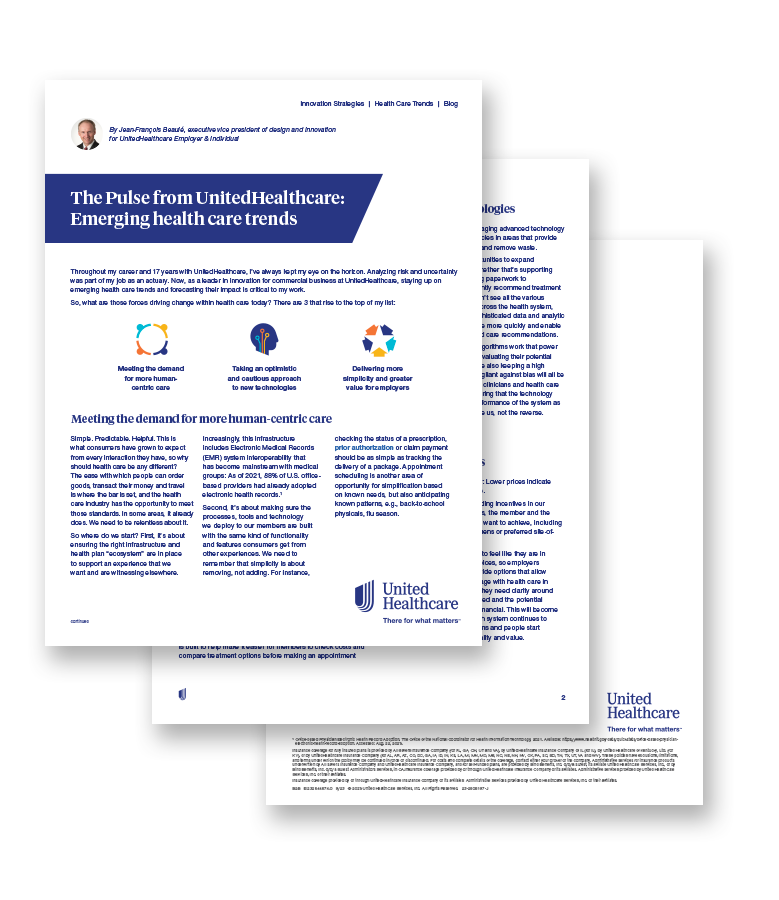The Pulse from UnitedHealthcare: Emerging health care trends
Jean-François Beaulé shares his perspective on 3 emerging trends he believes will help shape the future of health care — and their impact on employers and employees.

Throughout my career and 17 years with UnitedHealthcare, I've always kept my eye on the horizon. Analyzing risk and uncertainty was part of my job as an actuary. Now, as a leader in innovation for commercial business at UnitedHealthcare, staying up on emerging health care trends and forecasting their impact is critical to my work.
So, what are those forces driving change within health care today? There are 3 that rise to the top of my list:
Meeting the demand for more human-centric care
Simple. Predictable. Helpful. This is what consumers have grown to expect from every interaction they have, so why should health care be any different? The ease with which people can order goods, transact their money and travel is where the bar is set, and the health care industry has the opportunity to meet those standards. In some areas, it already does. We need to be relentless about it.
So where do we start? First, it's about ensuring the right infrastructure and health plan "ecosystem" are in place to support an experience that we want and are witnessing elsewhere. Increasingly, this infrastructure includes Electronic Medical Records (EMR) system interoperability that has become mainstream with medical groups: As of 2021, 88% of U.S. office-based providers had already adopted electronic health records.1
Second, it’s about making sure the processes, tools and technology we deploy to our members are built with the same kind of functionality and features consumers get from other experiences. We need to remember that simplicity is about removing, not adding. For instance, checking the status of a prescription, prior authorization or claim payment should be as simple as tracking the delivery of a package. Appointment scheduling is another area of opportunity for simplification based on known needs, but also anticipating known patterns, e.g., back-to-school physicals, flu season.
Taking an optimistic and cautious approach to new technologies
With one of the largest health care datasets in the nation, UnitedHealthcare is constantly seeking opportunities to streamline and better connect that data to more efficiently and effectively generate what matters most to our members and deliver a simpler, decluttered experience. Layering on advanced technologies that are powered by data can help us do that at greater speed.
With that said, we must proceed with caution. Storing, securing and manipulating data and deploying advanced analytics carry multiple risks and require the highest standard of stewardship.
At UnitedHealthcare, this means ensuring our data security standards, as well as those of the vendors we work with, continue to be at the highest level. Employers should likewise consider this when selecting their health plan and benefit vendors.
Innovations that marry data and technology are exciting. Strategically evaluating the applications that can drive the greatest value without creating unintended consequences matters.
This is why we're focusing on leveraging advanced technology to first improve operational efficiencies in areas that provide great benefit, improve satisfaction and remove waste.
In the future, there could be opportunities to expand applications to clinical domains, whether that's supporting providers with everything from filing paperwork to empowering them to more confidently recommend treatment paths. Because providers often don’t see all the various interactions a member may have across the health system, technologies that are built with sophisticated data and analytic models could help patients get care more quickly and enable more personalized, evidence-based care recommendations.
Understanding how the data and algorithms that power these emergent technologies and evaluating their potential applications — and limitations — while also keeping a high standard of ethics and remaining vigilant against bias will all be important moving forward. Training clinicians and health care professionals is also critical to ensuring that the technology benefits patients, as well as the performance of the system as a whole. Technology is here to serve us, not the reverse.
Delivering more simplicity and greater value for employers
Another trend concerning employers surrounds the persisting challenges of affordability in health care, as well as balancing what sometimes appears to be a growing need, for example, in the broad areas of well-being and mental health. As a result, health plan offerings that can work to help employees find proven quality care that is cost-effective, as well as be competitively differentiating, are most attractive to employers.
Part of the challenge in designing these offerings is that people often have negative reactions to being told what to do or where to go for care, even when deployed with best intentions. With trust being somewhat fragile, benefits strategy is about offering compelling alternatives rather than absolutes and then orchestrating the "choice" experience by making certain options more valuable (in terms of convenience, cost, etc.) than others.
At UnitedHealthcare, an example of this is with our Surest™ offering, a UnitedHealthcare company. The Surest health plan is built to help make it easier for members to check costs and compare treatment options before making an appointment or filling a prescription. Even better: Lower prices indicate providers evaluated as higher value.
Another example is how we're building incentives in our contracts that align provider groups, the member and the employer around the outcomes we want to achieve, including preventive care, chronic care regimens or preferred site-of-care use when quality is similar.
At the end of the day, people want to feel like they are in control of their health and care choices, so employers and health plans alike need to provide options that allow individuals to understand and engage with health care in the way they feel most confident. They need clarity around the value of the options being offered and the potential risks involved, whether clinical or financial. This will become increasingly important as the health system continues to innovate with more care path options and people start to seek out more convenience, quality and value.
